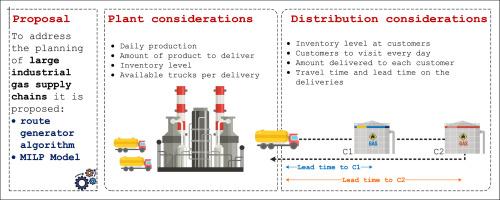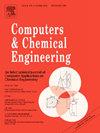A MILP-based approach to address the production and distribution planning of large industrial gas supply chains
IF 3.9
2区 工程技术
Q2 COMPUTER SCIENCE, INTERDISCIPLINARY APPLICATIONS
引用次数: 0
Abstract
This paper focuses on addressing the Production Routing Problem (PRP) of industrial gas supply chains (SC). The work introduces a Mixed-Integer Linear Programming (MILP) based approach to effectively tackle this challenging problem. The proposed framework aims to increase company profits by optimizing both production and distribution activities simultaneously. For the distribution part, a route generation algorithm is employed to initially generate a set of feasible routes, ensuring that only routes with practical significance are considered. Subsequently, the mathematical model is developed considering only the set of routes generated. The formulation includes decisions associated with plants production levels, plant selection to supply the different consumers, clients to be visited per trip and day, quantity to be delivered and routes to be used. As part of the problem, it is considered that trucks can make several trips per day, as well as trips of several days. To take into account the last feature, the approach accounts for the explicit effect of the lead time on production and distribution decisions. In this way, the work allows for different delivery times for customers included in the same route, according to their inventories and usage levels. The model considers fleet unavailability until they return to the plants after finishing a trip. Finally, two case studies, one motivating and the other industrial size, are presented and solved. The results obtained demonstrate the effectiveness of the proposed approach to solve the case studies in reasonable CPU times.

用基于 MILP 的方法解决大型工业气体供应链的生产和配送规划问题
本文重点讨论工业气体供应链(SC)的生产路径问题(PRP)。该工作引入了一种基于混合整数线性规划(MILP)的方法,以有效解决这一具有挑战性的问题。所提出的框架旨在通过同时优化生产和配送活动来增加公司利润。对于配送部分,采用了路线生成算法来初步生成一组可行路线,确保只考虑具有实际意义的路线。随后,只考虑生成的路线集,建立数学模型。数学模型的制定包括与工厂生产水平相关的决策、为供应不同消费者而选择的工厂、每次行程和每天要访问的客户、要交付的数量以及要使用的路线。作为问题的一部分,考虑到卡车每天可以行驶数次,也可以行驶数天。考虑到最后一个特点,该方法考虑到了交货期对生产和配送决策的明确影响。通过这种方法,可以根据客户的库存和使用水平,为同一路线上的客户提供不同的交货时间。该模型还考虑了车队在结束行程返回工厂之前的不可用性。最后,介绍并解决了两个案例研究,一个是激励案例,另一个是工业规模案例。所获得的结果表明,所提出的方法能够在合理的 CPU 时间内有效地解决案例研究。
本文章由计算机程序翻译,如有差异,请以英文原文为准。
求助全文
约1分钟内获得全文
求助全文
来源期刊

Computers & Chemical Engineering
工程技术-工程:化工
CiteScore
8.70
自引率
14.00%
发文量
374
审稿时长
70 days
期刊介绍:
Computers & Chemical Engineering is primarily a journal of record for new developments in the application of computing and systems technology to chemical engineering problems.
 求助内容:
求助内容: 应助结果提醒方式:
应助结果提醒方式:


